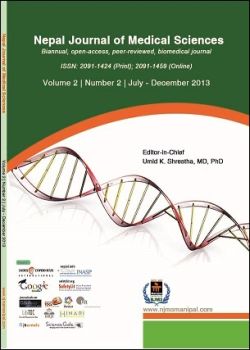Prevalence of Congenital Heart Disease in Neonate in a Tertiary Level Hospital
DOI:
https://doi.org/10.3126/njms.v2i2.8942Keywords:
Congenital, heart disease, prevalenceAbstract
Background: Congenital heart disease (CHD) has already been recognized as one of the important cause of neonatal mortality and morbidity. The reported prevalence of CHD in live newborns tends to vary a lot due to various unrecognizable lesions at birth and lack of technical expertise.
Methods: A cross sectional study was carried out in the department of Neonatology at Mymensingh Medical College Hospital (MMCH), Bangladesh from January to December 2010 to find prevalence of CHD in neonates.
Results: Out of 6560 admitted neonates, 51 were found to have CHD. The prevalence was 7.8/1000 live births. Mean age was 10.2±9.8 days and weight was 2380.5±590.5gms. Respiratory distress was the commonest symptom (71%) followed by cyanosis (26%) and reluctant to feed (24%). Among the CHD Ventricular septal defect (VSD) was the commonest 15/51 and then Atrial septal defect (ASD) 12/51, Patent ductus arteriosus (PDA) 5/51, Transposition of great arteries ( TGA) 4/51, Complex heart disease 4/51 and Tetralogy of Fallot (TOF) 3/51 cases. Some associated non-cardiac anomalies like Down’s syndrome, polydactyly, syndactyly, cleft lip, cleft palate and cataract were found. Risk factors associated with CHD were diabetes mellitus (10%), hypertension (8%) and maternal infection (4%). Among the drugs, anti-pyretic by 20%, anti-emetic by 18%, anti-epileptic by 4%, vitamin-A and hormone each by 2% of mothers respectively.
Conclusion: VSD and ASD were the commonest CHD in this study. Thorough clinical examination and proper investigations immediately after admission is essential, which may help us for proper counseling and early intervention.
Nepal Journal of Medical Sciences | Volume 02 | Number 02 | July-December 2013 | Page 91-95
Downloads
Downloads
Published
How to Cite
Issue
Section
License
Copyright © by Nepal Journal of Medical Sciences. The ideas and opinions expressed by authors of articles summarized, quoted, or published in full text in this Journal represents only opinions of authors and do not necessarily reflect the official policy of Nepal Journal of Medical Sciences or the institute with which the author(s) is (are) affiliated, unless so specified.




